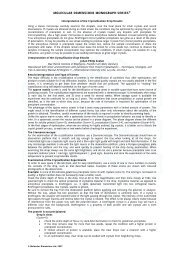(IEA Energy Papers 2011_05) Matthias Finkenrath-Cost and Performance of Carbon Dioxide Capture from Power Generation (IEA Energy Papers)-OECD Publishing (2011)
Create successful ePaper yourself
Turn your PDF publications into a flip-book with our unique Google optimized e-Paper software.
<strong>Cost</strong> <strong>and</strong> <strong>Performance</strong> <strong>of</strong> <strong>Carbon</strong> <strong>Dioxide</strong> <strong>Capture</strong> <strong>from</strong> <strong>Power</strong> <strong>Generation</strong> ©<strong>OECD</strong>/<strong>IEA</strong> <strong>2011</strong><br />
Table 2. Techno‐economic assumptions typically used by different organisations, <strong>and</strong> in this analysis<br />
Page | 20<br />
Organisation CCP CMU EPRI GCCSI GHG IA NETL NZEC MIT<br />
This study<br />
(based on<br />
<strong>OECD</strong>, 2010)<br />
Discount rates 10% 9‐10% 9% 10% 10% 10% 10%<br />
Owner's cost 5‐7% 15% 7% 15‐25% 7% 10% 15%<br />
Capacity factor, coal 75% 80% 85% 85% 85% 85% 85% 85%<br />
Capacity factor, natural gas 95% 75% 85% 85% 85%<br />
Economic life, coal 30 yrs 30 yrs 30 yrs 25 yrs 30 yrs 25 yrs 20 yrs 40 yrs<br />
Economic life, natural gas 25 yrs 30 yrs 30 yrs 25 yrs 30 yrs 30 yrs<br />
Construction time, coal 4 yrs 4 yrs 3 yrs 3 yrs 3yrs 4 yrs<br />
Construction time, natural gas 3 yrs 2 yrs<br />
Contingencies with CCS 20% 5‐30% 13‐14% 5‐20% 10% 15‐20% 10% 15%<br />
Values <strong>of</strong> by‐products or waste generated in the power plants, such as sulphur, gypsum <strong>and</strong> slag<br />
or ash, are assumed a zero net cost. At the end <strong>of</strong> the project lifetime, 5% <strong>of</strong> overnight costs is<br />
applied in cost calculations for decommissioning. Assumptions on fuel prices vary across regions<br />
<strong>and</strong> are summarised in Box 1.<br />
Box 1. Fuel price assumptions<br />
Common fuel prices that remain constant over the entire lifetime <strong>of</strong> the plant are assumed for<br />
evaluating electricity generation costs. This study uses for consistency fuel prices for bituminous coals<br />
<strong>and</strong> natural gas as defined in the <strong>OECD</strong> PCGE 2010 publication (even though in particular natural gas<br />
prices are currently lower). Sub‐bituminous coals <strong>and</strong> lignite are typically not traded on an<br />
international level. Hence for these coals national fuel price assumptions are used. Since across the<br />
data covered by this review sub‐bituminous coals <strong>and</strong> lignite are only used in US plants, fuel prices as<br />
reported by DOE/NETL are assumed (NETL, 2010e). Following similar considerations, the fuel price for<br />
biomass, which is only used in a single case for co‐firing, is based on assumptions <strong>from</strong> the underlying<br />
study (GHG IA, 2009).<br />
In summary, the following fuel prices are assumed in this study:<br />
<strong>OECD</strong> Europe<br />
• Bituminous coal: USD 3.60 per gigajoule (/GJ) (USD 90/tonne)<br />
• Natural gas: USD 9.76/GJ (USD 10.30/MBtu)<br />
• Biomass: USD 11.32/GJ<br />
United States<br />
• Bituminous coal: USD 2.12/GJ (USD 47.60/tonne)<br />
• Natural gas: USD 7.40/GJ (USD 7.78/MBtu)<br />
• Sub‐bituminous coal: USD 0.72/GJ (USD 14.28/tonne)<br />
• Lignite: USD 0.86/GJ (USD 13.19/tonne)<br />
China<br />
• Bituminous coal: USD 2.95/GJ (USD 86.34/tonne)<br />
• Natural gas: USD 4.53/GJ (USD 4.78/MBtu)<br />
Conversion between lower (LHV) <strong>and</strong> higher heating value (HHV) thermal plant efficiencies is<br />
simplified based on <strong>IEA</strong> conventions, with a 5% difference for coal <strong>and</strong> 10% for natural gas.




